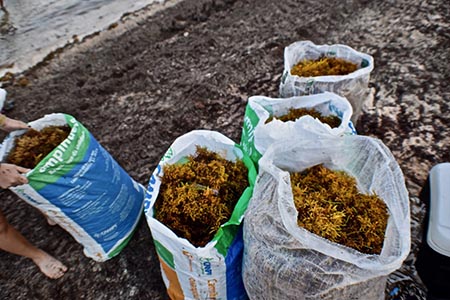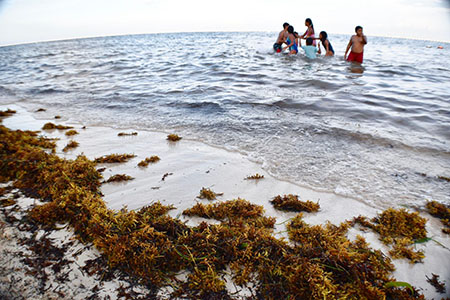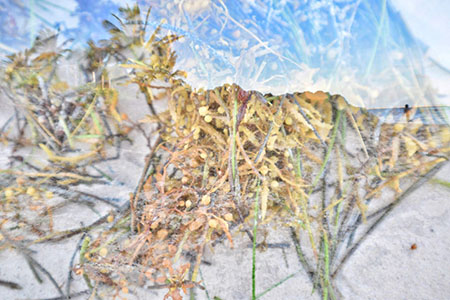
Close-up of sargasso, Puerto Morelos, 2019. Photo by the author.
Sitting in her office, I could smell the sharp scent of hydrogen sulfide coming from the beach. She turned to me, paused for a second and proceeded to say with a seriousness in her tone that I hadn’t anticipated: The ecosystem that I have been studying all my life is now disappearing in a matter of weeks.
Sargasso was once confined to the limits of the Sargasso Sea in the Atlantic Ocean. As an ecological system, the Sargasso Sea has no land boundaries and its biological containment relies entirely on a delicate balance of ocean currents. Unlike other ecosystems, it lends itself to an almost poetic reimagination of what an ecosystem is. On the West, the sea bounded by Gulf Stream; on the North, by the North Atlantic Current; on East by the Canary Current; and on the South by the North Equatorial Current. It was first described by Cristopher Columbus in 1492 during his journey to the Americas. Ever since, its origins and movements across the Atlantic Ocean have been a source of debate and wonder. It wasn’t until 1834 that the German botanist Meyen F. J. F. proposed the idea that sargassum was an ecosystem entirely independent of any land, a floating ecosystem. He was also the first person who suggested that sargassum reproduces itself in the middle of the ocean instead of coming from any given territory (Deacon, 1942).
As marine biologists are quick to note, there was neither a need nor a real interest in studying the Sargasso Sea in depth until the year of 2011. The few times the Sargasso Sea became an object of scientific inquiry, it was studied exclusively through the lens of conservation. When the Sargasso Sea Alliance was created in 2010, its aim was to protect the heaven of biodiversity that this ecosystem represented, supporting the life cycle of the threatened and endangered species that live in it. However by 2011, scientific interest in sargassum changed rapidly. What was seen in 2011 as an environmental abnormality was later understood to be a long-term problem redefining the ecology of the region and endangering the very existence of life in the Caribbean. Sargassum went from being an endangered habitat to an invasive species and a pollutant, as massive volumes of the algae were landing on the shores of Africa, South America and the Caribbean. By 2018 it was clear that scientists, policy makers, business owners, and politicians had to deal with the unexpected consequences of what had by then developed into a collision of two ecosystems: the Sargasso Sea and the Coral Reefs of the Caribbean.

People use whatever they have around to collect the sargasso on the beach. Puerto Morelos, 2019. Photo by the author.
The extraordinarily large volume of sargassum arriving into the Caribbean over the last years has severely eutrophicated its shores. Corals that developed over forty years are dying in a matter of weeks. Along with depleting the ocean’s oxygen level, Sargassum is also bringing new organisms into the Atlantic Ocean: scientists at National Autonomous University of Mexico (UNAM) have counted as many as 74 different organisms that travel with the Sargasso Sea ecosystem to the coast of Mexico. New diseases such as White Syndrome—responsible for the massive deaths of corals—have emerged in the region. Because the Sargasso Sea was not extensively studied to begin with, scientists find themselves lacking even the most basic biological knowledge to begin explaining why the Atlantic shores are now covered with it. While most, if not all agree that global environmental change is likely responsible, the exact cause (temperature, ocean currents, availability of macronutrients in the ocean, the flow of dust coming from the African continent, etc.) remains unknown.
Taxonomy and boundary work

A family in the newly emptied beach covered with sargasso. Puerto Morelos, 2019. Photo by the author.
The Sargasso Sea’s collision with the Caribbean pushes us to find new ways of thinking beyond taxonomy and boundary work. Scientists in the region are even unsure of how many species of algae are arriving to the shores of the Atlantic Ocean: it could be only one, or it could be as many as five different species. This lack of knowledge matters: the taxonomy of the sargassum in the Caribbean can entirely change how we think of this as an environmental issue. Identifying all the sargassum arriving to the shore as only one species—morphologically or genetically—would automatically make the sargassum issue a global problem. Identifying the sargassum as five different species, on the other hand, would instead fragment the issue into a collection of regional environmental problems. In other words, having two, three, four or five different species of the alga across the ocean would make the sargassum issue a problem of multiple colonies of sargassum growing at different sites and just not one of a single species invading the shores of the Atlantic Ocean. The taxonomy of the sargasso doesn’t just define the biological boundaries that we associate with the fixity of a species. It also defines the global or regional trajectories that we evoke in our explanations of environmental problems and the solutions we devise to those problems. As we can see, the taxonomic definition of the alga is tied to the explanations of the problem and its consequences.
A similar issue of boundary-making and difference created in the movement of the alga across the ocean is seen with the ambiguous legal and political status of the alga. As sargassum moves across the ocean to the shores of Mexico it acquires contradictory legal definitions and becomes the responsibility of different government offices. When in the water, the alga is the responsibility of the government office for fishing resources whereas on the shore it becomes the responsibility of the ministry of the environment. Similarly, when the problem was first identified, it was defined as the responsibility of the Secretariat of Environment and Natural Resources (SEMARNAT). But as it began to be seen as an international problem, it became the responsibility of the Secretariat of Foreign Affairs (SRE). And recently, it has become the responsibility of the Secretariat of the Navy (SEMAR)—given their presumed ability to employ their military infrastructure to better deal with the scale of the problem.

Double-exposure photo of a pile of decomposing and the fresh sargasso. Puerto Morelos, 2019. Photo by the author.
From ecosystem to pollutant: trajectories of difference
At some point in between the Sargasso Sea and the shores of the Atlantic Ocean, sargassum becomes a powerful pollutant and stops being an ecosystem. This classification technically changes depending on the point of the alga’s trajectory from the Sargasso Sea to the shore, and yet it remains both an ecosystem and a pollutant. For a long time, anthropologists (Leigh Star & Griesemer, 1989; Leigh Star, 2010; Helmreich, 2005) have productively used the heuristic of “boundary objects” or “shifting boundaries” to study issues of taxonomy and biological classification. But the story of sargassum suggests that thinking exclusively in terms of shifting or flexible boundaries ignores the ways movement creates its own forms of difference and continuity. The limits, lines, and boundaries evoked by scientists to talk about this alga seem to point to the capacity of movement itself to be a category of biological and social differences. For this reason, perhaps we need to find other ways of engaging with environmental movement and its production of differences. At a time when we have to face the consequences of global environmental change; the movement of species, ecosystems, pollutants, and biological frontiers forces us to come up with new ways of analyzing global environmental flows. We are witnessing a clash of social and ecological spaces that we do not yet know how to speak of. For now, the case of sargassum on the shore of Mexico offers us the possibility of rethinking how the flows that define the Sargasso Sea need to be understood alongside their global difference-making trajectories.
References
Deacon, G. E. R. (1942). The Sargasso Sea. The Geographical Journal, 99(1), 16-28.
Helmreich, S. (2005). How scientists think; about ‘natives’, for example. A problem of taxonomy among biologists of alien species in Hawaii. Journal of the Royal Anthropological Institute, 11(1), 107-128.
Leigh Star, S. (2010). This is not a boundary object: Reflections on the origin of a concept. Science, Technology, & Human Values, 35(5), 601-617.
Leigh Star, S., & Griesemer, J. R. (1989). Institutional ecology, translations’ and boundary objects: Amateurs and professionals in Berkeley’s Museum of Vertebrate Zoology, 1907-39. Social studies of science, 19(3), 387-420.
